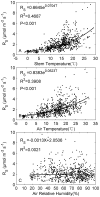Diurnal and seasonal change in stem respiration of Larix principis-rupprechtii trees, northern China
- PMID: 24586668
- PMCID: PMC3935864
- DOI: 10.1371/journal.pone.0089294
Diurnal and seasonal change in stem respiration of Larix principis-rupprechtii trees, northern China
Abstract
Stem respiration is a critical and uncertain component of ecosystem carbon cycle. Few studies reported diurnal change in stem respiration as well as its linkage with climate. In this study, we investigated the diurnal and seasonal change in stem respiration and its linkage with environmental factors, in larch plantations of northern China from 2010 to 2012. The stem respiration per unit surface area (RS) showed clear diurnal cycles, ranging from 1.65±0.10 to 2.69±0.15 µmol m(-2) s(-1), increased after 6∶00, peaked at 15∶00 and then decreased. Both stem temperature and air temperature show similar diurnal pattern, while the diurnal pattern of air relative humidity is just the opposite to Rs. Similar to the diurnal cycles, seasonal change in RS followed the pattern of stem temperature. RS increased from May (1.28±0.07 µmol m(-2) s(-1)) when the stem temperature was relatively low and peaked in July (3.02±0.10 µmol m(-2) s(-1)) when the stem temperature was also the highest. Further regression analyses show that RS exponentially increases with increasing temperature, and the Q10 of Rs at mid daytime (1.97±0.17 at 12∶00 and 1.96±0.10 at 15∶00) is significantly lower than that of mid nighttime (2.60±0.14 at 00∶00 and 2.71±0.25 at 03∶00) Q10. This result not only implies that Rs is more sensitive to night than day warming, but also highlights that temperature responses of Rs estimated by only daytime measurement can lead to underestimated stem respiration increase under global warming, especially considering that temperature increase is faster during nighttime.
Conflict of interest statement
Figures





References
-
- IPCC, 2007 Climate Change (2007) The Physical Sciences Basis: Contribution of Working Group I to the Fourth Assessment Report of the Intergovernmental Panel on Climate Change. Cambridge: Cambridge University Press. 235–337.
-
- Pan Y, Birdsey RA, Fang JY, Houghton R, Kauppi PE, et al. (2011) A Large and Persistent Carbon Sink in the World’s Forests. Science 988: 988–993. - PubMed
-
- Janssens IA, Kim P (2003) Large seasonal changes in Q10 of soil respiration in a beech. Global Change Biol 9: 911–918.
-
- Davidson EA, Janssens IA, Luo YQ (2006) On the variability of respiration in terrestrial ecosystems: moving beyond Q10 . Global Change Biol 12: 154–164.
-
- Peng SS, Piao SL, Wang T, Sun JY, Shen ZH (2009) Temperature sensitivity of soil respiration in different ecosystems in China. Soil Biol Biochem 41: 1008–1014.
Publication types
MeSH terms
LinkOut - more resources
Full Text Sources
Other Literature Sources

